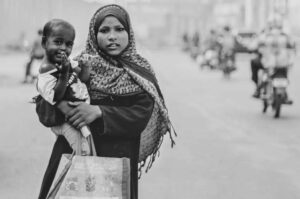Gender gap: India’s growth story is failing its women | Policy Circle – policycircle.org

Report on Gender Inequality and its Impact on India’s Sustainable Development Goals
Executive Summary
Despite significant economic progress, India’s development is constrained by a persistent gender gap, which directly impedes the nation’s ability to achieve the Sustainable Development Goals (SDGs). With a ranking of 131 out of 148 countries in the 2025 Global Gender Gap Report and a female labour force participation rate below 24%, the exclusion of nearly half the population undermines progress across multiple goals. This report analyzes the dimensions of this gap and proposes reforms to align India’s growth trajectory with the 2030 Agenda for Sustainable Development, with a primary focus on SDG 5 (Gender Equality) and its intersection with SDG 8 (Decent Work and Economic Growth), SDG 10 (Reduced Inequalities), and SDG 16 (Peace, Justice and Strong Institutions).
Analysis of the Gender Gap in Relation to Key SDGs
SDG 5 & SDG 8: Economic Participation and Decent Work
The failure to achieve gender equality (SDG 5) directly compromises the goal of promoting sustained, inclusive, and sustainable economic growth and decent work for all (SDG 8). The economic contribution of women remains disproportionately low.
- Contribution to GDP: Women contribute only 18% to India’s GDP.
- Labour Force Participation: Female labour force participation has declined from 32% in 2005 to under 24% in 2024.
- Informal Sector Dominance: Over 90% of employed women are engaged in insecure, low-paid work in the informal sector, lacking social protection and decent working conditions.
- Economic Cost of Exclusion: Closing the gender gap in the workforce could add an estimated $770 billion to India’s GDP, highlighting that exclusion is a significant economic burden.
SDG 10 & SDG 4: Reduced Inequalities and Education
Aggregate progress in development masks deep-seated inequalities (SDG 10). While India has improved access to education (SDG 4), these gains are not translating into equitable opportunities for women.
- Education-Employment Disconnect: Increased school and university enrolment for women has not led to a corresponding rise in employment or leadership roles.
- Unpaid Labour: Women perform over 85% of unpaid domestic and care work. This invisible economy, estimated to be worth nearly 40% of GDP, is not measured in traditional development metrics, perpetuating economic inequality.
- Structural Barriers: Restrictive social norms, safety concerns, and the unequal burden of domestic responsibilities are key factors preventing women from participating in the formal economy.
SDG 11 & SDG 16: Sustainable Communities and Strong Institutions
The lack of gender-sensitive infrastructure and weak institutional enforcement hinders progress towards creating safe, inclusive communities (SDG 11) and ensuring justice for all (SDG 16).
- Inadequate Public Infrastructure: A lack of safe public transport, affordable childcare facilities, and gender-sensitive urban planning acts as a major barrier to women’s mobility and economic participation.
- Weak Legal Enforcement: While laws such as the Maternity Benefit Act and the Domestic Violence Act exist, their enforcement is inconsistent, particularly in the informal economy where the majority of women work.
- Fragmented Policy Response: Government schemes have raised awareness but have not sufficiently addressed the structural barriers. Gender budgeting, introduced in 2005, has yet to become a robust tool for systemic change.
Recommendations for Institutional Reform to Achieve the SDGs
Strategic Policy and Institutional Reforms
To reverse current trends, India must embed gender equality into its core development strategy. The following institutional reforms are recommended:
- Mainstream Gender in Economic Planning: Adopt gender equality as a primary metric for development, not an afterthought. All budget planning, infrastructure projects, and welfare schemes must be evaluated through a gender lens to directly support SDG 5 and SDG 10.
- Strengthen Institutional Mechanisms: Enhance the scope and implementation of gender budgeting to ensure it functions as an effective planning and accountability tool. Bolster the enforcement of all legal protections for women.
- Invest in Enabling Infrastructure: Prioritize public investment in affordable, high-quality childcare; safe and accessible public transportation; and gender-inclusive urban design. These are prerequisites for achieving SDG 5 and SDG 11.
- Recognize and Redistribute Unpaid Care Work: Develop policies to measure, value, and redistribute unpaid care work, which is fundamental to creating a level playing field for women in the economy.
Fostering an Inclusive Economy for Decent Work (SDG 8)
Workplaces and economic systems must be transformed to be inclusive and equitable.
- Promote Women’s Economic Agency: Scale up and institutionalize successful self-help group models that treat women as economic agents.
- Enforce Workplace Equality: Mandate and enforce policies on equal pay for work of equal value, establish robust anti-harassment protocols, and normalize parental leave for all genders to create supportive work environments.
- Bridge the Digital and Skill Gaps: Implement targeted skill development programs designed to accommodate women’s time and mobility constraints. Focus on closing the digital gender gap to ensure women can participate in the tech-driven economy.
Analysis of Sustainable Development Goals in the Article
1. Which SDGs are addressed or connected to the issues highlighted in the article?
- SDG 5: Gender Equality: This is the central theme of the article. It directly discusses the “persistent gender inequality” in India, covering economic participation, political empowerment, unpaid domestic work, and the impact of patriarchal norms.
- SDG 8: Decent Work and Economic Growth: The article extensively links gender inequality to economic outcomes. It discusses the low female labour force participation, the prevalence of women in “insecure, low-paid, informal sector jobs,” the call for equal pay, and the massive economic potential lost ($770 billion) by not closing the gender gap.
- SDG 10: Reduced Inequalities: The article frames the gender gap as a form of systemic inequality that undermines inclusive growth. It highlights how “aggregate progress masks deep social asymmetries” and how development leaves behind nearly half the population, which is a core concern of SDG 10.
- SDG 4: Quality Education: The article connects education to employment outcomes for women. It notes that while “School and university enrolment have improved,” these educational gains “rarely translate into jobs or leadership roles,” pointing to a systemic failure to leverage educational achievements for gender equality.
- SDG 11: Sustainable Cities and Communities: The article identifies structural barriers related to urban and public infrastructure that hinder women’s economic participation. It specifically mentions “inadequate public transport,” “safety concerns,” and the need for “safe public spaces” and “gender-sensitive urban planning.”
2. What specific targets under those SDGs can be identified based on the article’s content?
- Target 5.1: End all forms of discrimination against all women and girls everywhere. The article points to “restrictive social norms” and “the weight of patriarchy” as fundamental barriers limiting women’s access to the job market and public life.
- Target 5.4: Recognize and value unpaid care and domestic work. This is explicitly addressed when the article states that “unpaid domestic labour, overwhelmingly performed by women, remains invisible” and that women “perform over 85% of unpaid household labour.”
- Target 5.5: Ensure women’s full and effective participation and equal opportunities for leadership in political, economic and public life. The article highlights failures in this area by citing low “political empowerment” (13.8%), the fact that educational gains do not translate into “leadership roles,” and the low overall economic participation of women.
- Target 5.b: Enhance the use of enabling technology… to promote the empowerment of women. The article directly calls for this when it states that the “digital gender gap… must be addressed.”
- Target 8.5: Achieve full and productive employment and decent work for all women and men… and equal pay for work of equal value. The article focuses on this target by discussing the low “female labour force participation” (below 24%), the fact that over 90% of employed women are in “insecure, low-paid, informal sector jobs,” and the need for “Equal pay.”
- Target 8.8: Protect labour rights and promote safe and secure working environments for all workers. This is relevant as the article mentions “safety concerns” as a barrier to work and notes that “Legal safeguards for workplace safety… are inconsistently applied,” especially in the informal economy where most women work.
- Target 11.2: Provide access to safe, affordable, accessible and sustainable transport systems for all. The article identifies “inadequate public transport” as a key structural factor limiting women’s participation in the workforce.
3. Are there any indicators mentioned or implied in the article that can be used to measure progress towards the identified targets?
- Global Gender Gap Index Rank: The article states India ranks 131 out of 148 countries, providing a clear, high-level indicator of overall gender inequality.
- Female Labour Force Participation (FLFP) Rate: A key indicator used throughout the article, cited as falling from 32% in 2005 to “below 24% in 2024.”
- Proportion of Women in Informal Employment: The article states that “Over 90% of employed women work in insecure, low-paid, informal sector jobs,” which is a direct measure of the quality and security of work.
- Women’s Contribution to GDP: Mentioned as being “just 18%,” this indicator measures the economic output of women relative to their population size.
- Proportion of Time Spent on Unpaid Domestic and Care Work: The article implies this indicator by stating that “Women perform over 85% of unpaid household labour.”
- Proportion of Seats Held by Women in National Parliaments: This is implied through the discussion of low “political empowerment” (13.8%) and the contrasting example of Rwanda reserving over 60% of parliamentary seats for women.
- Gender Gap in Employment (Urban/Rural): The article cites CMIE data that “just 9% of urban working-age women are employed or seeking work, compared to 67% of men,” providing a specific indicator of the employment gap.
SDGs, Targets, and Indicators from the Article
| SDGs | Targets | Indicators |
|---|---|---|
| SDG 5: Gender Equality |
5.1: End discrimination against women.
5.4: Recognize and value unpaid care and domestic work. 5.5: Ensure women’s full participation and equal opportunities for leadership. 5.b: Enhance the use of enabling technology for women’s empowerment. |
Global Gender Gap Index rank (131 out of 148).
Proportion of time spent on unpaid household labour (over 85% performed by women). Political empowerment score (13.8%). Mention of the need to close the “digital gender gap.” |
| SDG 8: Decent Work and Economic Growth |
8.5: Achieve full and productive employment and decent work for all, and equal pay.
8.8: Protect labour rights and promote safe and secure working environments. |
Female labour force participation rate (below 24%).
Proportion of women in informal, insecure jobs (over 90%). Women’s contribution to GDP (18%). Inconsistent application of legal safeguards for workplace safety. |
| SDG 10: Reduced Inequalities | 10.2: Empower and promote the social, economic and political inclusion of all, irrespective of sex. |
Urban employment gap (9% of women vs. 67% of men employed or seeking work).
Economic participation gap (40.7% for women). |
| SDG 11: Sustainable Cities and Communities | 11.2: Provide access to safe, affordable, and sustainable transport systems for all. | Mention of “inadequate public transport” and “safety concerns” as barriers to women’s economic participation. |
Source: policycircle.org

What is Your Reaction?
 Like
0
Like
0
 Dislike
0
Dislike
0
 Love
0
Love
0
 Funny
0
Funny
0
 Angry
0
Angry
0
 Sad
0
Sad
0
 Wow
0
Wow
0



























;Resize=805#)

















































